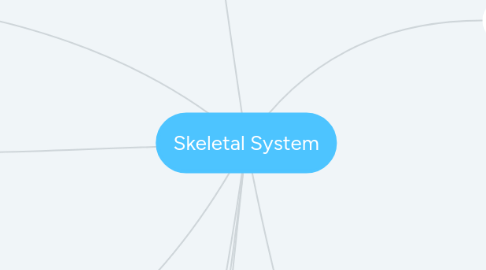
1. Ligaments
1.1. Definition
1.1.1. A short band of tough, flexible, fibrous connective tissue that connects bone to bone
2. Axial
2.1. Consists of
2.1.1. Skull
2.1.2. Thoracic cavity
2.1.3. Vertebral Column
3. Appendicular
3.1. Consists of
3.1.1. Limbs of the body
3.1.2. Pectoral Girdle
3.1.3. Pelvic Girdle
4. Bones
4.1. Examples
4.1.1. Short Bones
4.1.1.1. Examples
4.1.1.1.1. Hands
4.1.1.1.2. Feet
4.1.2. Irregular Bones
4.1.2.1. Examples
4.1.2.1.1. Spinal Cord
4.1.2.1.2. Pelvis Bones
4.1.2.1.3. Skull Bones
4.1.3. Flat Bones
4.1.3.1. Examples
4.1.3.1.1. Head
4.1.3.1.2. Ribs
4.1.3.1.3. Sternum
4.1.3.1.4. Scapulae
4.1.4. Long Bones
4.1.4.1. Eamples
4.1.4.1.1. Arm
4.1.4.1.2. Leg
4.1.4.2. Consists of
4.1.4.2.1. Diaphasis
4.1.4.2.2. Epiphysis
5. Tendons
5.1. Definition
5.1.1. A Flexible but inelastic cord of strong fibrous college tissue attaching muscle to bone
5.2. Examples
5.2.1. Foot
5.2.1.1. Achilles Tendon
5.2.1.1.1. The back part of your foot the keeps the stability of your ankle
6. Dieseses
6.1. Examples
6.1.1. Osteoporosis
6.1.1.1. Bones become braise and fragile due to loss of tissue
6.1.2. Scoliosis
6.1.2.1. When the backbone curves to the side
7. Fractures
7.1. Examples
7.1.1. Open, Displaced
7.1.1.1. Skin my be pierced by the bone at the time of the break
7.1.2. Greenstick
7.1.2.1. Happens in young or soft bones, the bones tends to bend and then break
7.1.3. Comminuted
7.1.3.1. Shattered into 3 or more pieces
7.1.4. Linear
7.1.4.1. A break that is a straight line and has a depressing towards the inside of the bone
7.1.5. Transverse, nondisplaced
7.1.5.1. Has a horizontal break line
7.1.6. Oblique, nondisplaced
7.1.6.1. Has a angled break
7.1.7. Spiral
7.1.7.1. Happens when a spiral rotation is applied to the axis of the bone and it breaks
7.1.8. Colles
7.1.8.1. Break in the distal radius of the wrist, happens when there is a fall on the outstretched hand
7.1.9. Pott
7.1.9.1. A break in the ankle bones that is characterized by a break in one or more malleoli
8. Joints
8.1. Definition
8.1.1. A point where two parts of the skeleton are joined together
8.2. Examples
8.2.1. Gliding Joint
8.2.1.1. Examples
8.2.1.1.1. Acromioclavicular going
8.2.1.1.2. Sternoclavicular joint
8.2.1.2. Definition
8.2.1.2.1. Gliding Joints
8.2.2. Hinge Joint
8.2.2.1. Examples
8.2.2.1.1. Elbow Joint
8.2.2.1.2. Knee Joint
8.2.2.1.3. Ankle Joint
8.2.2.2. Definition
8.2.2.2.1. Flection and extension at joints
8.2.3. Ball and socket joint
8.2.3.1. Examples
8.2.3.1.1. Shoulder Joints
8.2.3.1.2. Hip Joints
8.2.3.2. Definition
8.2.3.2.1. Flection/Extension/ Adduction/ Abduction/ internal and external rotation
8.2.4. Pivot joints
8.2.4.1. Examples
8.2.4.1.1. Atlas
8.2.4.1.2. Axis
8.2.4.2. Definition
8.2.4.2.1. Rotation of one bone around another
8.2.5. Saddle joints
8.2.5.1. Examples
8.2.5.1.1. First metacarpal joints
8.2.5.2. Definition
8.2.5.2.1. Flexion/ Extension/ Abduction/ Adduction/ circumduction
8.2.6. Condyloid Joint
8.2.6.1. Examples
8.2.6.1.1. Wrist Joints
8.2.6.2. Definition
8.2.6.2.1. Flexion/ Extension/ Abduction/ Adduction/ circumduction
9. Bone Cells
9.1. Types of Bone cells
9.1.1. Osteocytes
9.1.1.1. They maintain the matrix
9.1.1.2. Rebuild the matrix after destroying it with chemicals
9.1.1.3. Play a role in bone repair and remodling
9.1.1.4. Cannot divide
9.1.2. OsteoBlasts
9.1.2.1. Produce new bone matrix= Ossification
9.1.2.2. Make and release the proteins and other compounds of the matrix
9.1.2.3. Surrounded by Matrix
9.1.3. Osteoclasts
9.1.3.1. 50 or more nuclei
9.1.3.2. Remove and recycle bone matrix
9.1.3.3. Secrete acids and proteolytic enzymes to dissolve matrix and release stored minerals= Osteolysis

